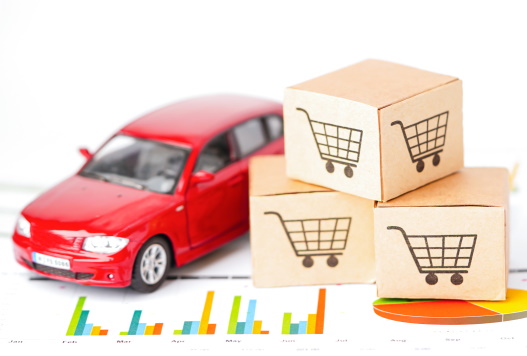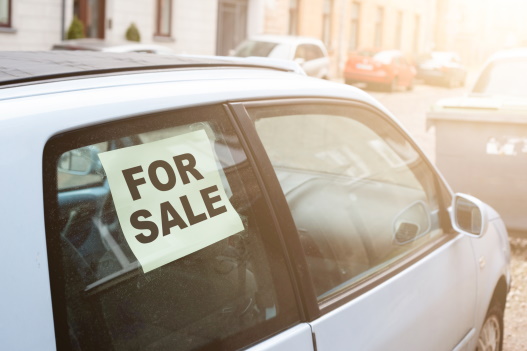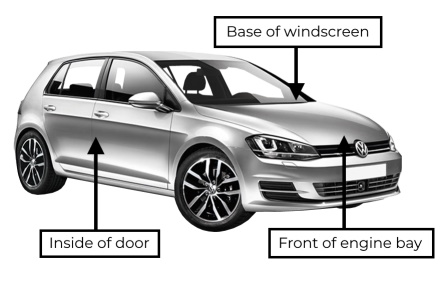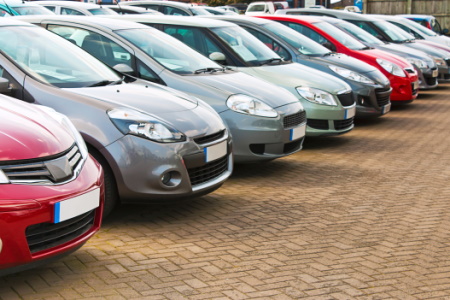Buying a used vehicle can be a daunting experience, so we've put together a guide to signpost areas of research we recommend you conduct and things that are important to check. We also look at the various buying options you have and set out some considerations for each.

Once you have found specific vehicles that you have shortlisted to buy run Total Car Checks for each to ensure they pass our rigorous data test and do not present any risks.
Making sure you follow our 10-step-guide below if you are buying from a private seller or have a look at what you should consider if you are buying from a retailer or auction.
This is really important otherwise you will be breaking the law. You could face the vehicle being seized, a hefty fine and be disqualified from driving. This includes making sure you are covered when taking a test drive.
Before you buy a vehicle it is essential that you conduct some research so you understand what makes, models and features of a car you are looking for and what you can afford before undertaking viewings.
The first step for most car buyers is understanding what models are available that suit their motoring needs. There are many websites that provide sophisticated search tools that enable you to find vehicles tailored to your requirements. The main areas to consider:
Once you have a general idea of what you are looking for from a vehicle then we suggest you formalise your criteria - defining ranges of tolerance for what you will and won’t consider. You can then focus your search on a range of makes/models and shortlist specific vehicles to view. An example is provided below. You can make this more or less detailed depending on how fussy you are about the vehicle you are looking for. But when you set a buying criteria make sure you stick to it and this will more likely lead you to getting hold of the right vehicle.
Example criteria:
Affordability is an important aspect of setting your buying criteria so you are able to run the vehicle. This should factor in the running costs over the entire period over which you plan to use the vehicle as well as an expectation of how much it will depreciate (lose value) over this time. All of this requires further research, here are the key areas to think about:
If you wish to see how much you can get for your vehicle consider using Motorway to get a free, instant valuation.
The amounts they offer will vary significantly. The funds generated from your existing vehicle can then be offset against the price of a new one. Our Gold Check provides a range of valuation information which will give you a good idea of what it should sell for to private buyers, dealers as a part exchange and at auction.Before you set off to view a vehicle make sure you buy our award-winning Gold Check. This will tell you if it passes our rigorous data inspection first before you’ve left the door. See a sample of the information we provide. Buying in bulk using our multi-gold deal gives you more value for money if you have more than one vehicle in your shortlist. The reports we provide can also be purchased and stored on our highly rated app and taken with you on your mobile phone to use in conjunction with physical checks you make on vehicles.
See an overview of the main risks that a Total Car Check protects against please click
Download Total Car Check app from iOS App Store for Apple devices
Download Total Car Check app from Google Play store for Android devices

There are estimated to be over 800,000 vehicles sold privately by individuals in the UK each year. It is easier than ever to sell cars privately given the range of websites and social media that enable advertisements to be posted, increasingly for free.
Why buy from a private seller?
There are many car owners that want to sell quickly for a variety of reasons and this often results in the price set way below what you would pay a retailer. It is easy to find vehicles online and if you have done your research you can pick up a real bargain. The downside is that you don’t get the same level of protection when buying privately, so conducting our Gold Check and making a series of spot checks when viewing vehicles is an absolute must. We have written a 10-step-guide below setting out everything you should check to give you a good purchase outcome.
10-step guide to viewing and checking vehicles
If you are new to buying cars it makes sense for you to appoint a vehicle inspection expert to come along to initial viewings with you. This could be a friend that works in the trade such as a mechanic or engineer, or there are a number of vehicle examination firms that you can approach to provide this service. Be wary of any sellers that are reluctant to facilitate any inspection requests you make.
This will help you both assess the vehicle's condition and an unscrupulous seller is less likely to invite you to their home (as you could easily inform the police of these details if there are any serious issues).
A genuine seller is unlikely to be concerned at this request, and it will enable you to check that the registered keeper (name on the V5C) is the person who is selling you the vehicle.
Make sure the seller has the DVLA V5C logbook registration document. If they don’t then walk away immediately, as there is no way for you to verify the important vehicle details. The seller should be named as the registered keeper on the V5C otherwise the vehicle might not be theirs to sell and it may be stolen.
Even if the seller is listed as the registered keeper it is important you conduct a Gold Check as the vehicle could hold outstanding finance and be owned by a finance provider. As stated on the document itself, a V5C is a record of ‘keepership’ not ‘ownership’.
It is important to check that the VIN, the engine number and the vehicle colour recorded in the V5C document match the vehicle. If they do not, the vehicle may be cloned. See guidance below on how to find the VIN and engine number.
Engine number, VIN checks and cloningIt is not uncommon for criminals to attempt to conceal the fact a vehicle is stolen by replacing its number plates with those of a very similar vehicle. This means that when you run a vehicle history check, you won't actually be checking the vehicle you think you are. This practise is known as cloning.
Fortunately, it is quite easy to check to see if a vehicle has been cloned by using its vehicle identification number (VIN):
How do I find the VIN?You must ensure that the VIN number provided in a Total Car Check report matches those displayed on the vehicle.
You can also use Total Car Check's free VIN check to see if the VIN matches the number plate registered aganst the vehicle.
The vehicle identification number is unique and will never change. It's normally 17 characters and a combination of letters and numbers.

You will normally find the VIN in three locations as shown in the above image:
Remember to check:
How do I find the engine number?
It is important to check that the engine number provided in a Total Car Check report matches the number inscribed onto the engine.
Open the bonnet of the vehicle. Lean under the open bonnet and look at the engine. On top of the engine, the engine number should be engraved into the metal.
If the engine number does not match the Total Car Check report ask the seller why. It is possible that the engine has been legitimately replaced, but this is very rare and, it also means that the mileage the engine has completed is now unknown.
It may also mean that the seller is attempting to disguise the identity of the vehicle. If the seller cannot explain the differences you notice, walk away.
How do I find the V5C date?
Never buy a vehicle without an accompanying V5C logbook. The V5C issue date should be clearly marked on the second page of all V5C logbooks.
If the issued date on the V5C logbook does not match the date on this report then you do not have the most up-to-date V5C logbook. This could mean that the seller is attempting to hide some of the vehicles history. You should not buy a vehicle without the most recent V5C logbook.
Stolen V5C logbooksIn 2006 2.2 million mostly blank V5C logbooks were stolen. Criminals have since attempted to use these to print their own. If the vehicle logbook has a reference number that falls within the ranges below, it is stolen and you should walk away immediately.
Stolen V5C Reference NumbersIf the reference number on the V5C logbook starts with BG or BI walk away.
An MOT is required each year for vehicles that are 3 or more years old. It ensures a vehicle is fit to be driven on UK roads and doesn’t pose a safety risk. All of our checks will confirm if the vehicle has passed its recent MOT and, if failed, tell you what the issue was. But it is worth you obtaining the MOT certificate from the seller just to confirm it is legal to drive on the road. A vehicle should be serviced annually, which is usually carried out when the MOT is undertaken. If no service history is made available then it might not have been properly maintained. You could also ask details of any recent new car parts fitted and if the seller has invoices/receipts to confirm this, such as new tyres, brake pads, spark plugs etc.
Our vehicle check reports will tell you if there are any mileage issues identified with the vehicle based on what is recorded with the DVSA after an MOT has been carried out. It is worth however checking the last recorded mileage reading on the vehicle check report against the odometer on the car to see if the values are aligned. Mileage should never go down, this is known as ‘clocking’.
It’s important you test the vehicle to ensure it meets your driving requirements and that there are no electrical and mechanical faults or overly worn parts (see section 6). Ask the seller if you can spend some time on a dual carriageway or motorway as well as on local B and C roads so you can see how the vehicle handles at both low and high speeds. But make sure you are adequately insured. If you have a fully comprehensive insurance policy you may be able to drive other vehicles or you might be insured through the seller’s policy. Check with your insurer before attending a viewing.
Do not handover any money to the seller until you have been handed the keys and you are satisfied with the vehicle’s condition. Never pay any funds to the seller as a deposit prior to viewing. If a deposit is requested beforehand then this is likely to be a scam and you should look for another vehicle. We recommend that you pay for the vehicle using an electronic transfer. Be cautious of any seller that refuses to provide their bank details and strictly requests a cash payment.
It's surprising how often people do not get a receipt for the purchase of a vehicle. Ask the seller to provide a receipt (even if hand-written) confirming the purchase as this serves as a contract. If there are any issues following the handover this provides some evidence to show that the seller agreed to release the vehicle for an agreed sum of money. It should therefore contain the agreed sum and be signed by both you and the seller.

Retailers come in all shapes and sizes, from a single site forecourt offering only a handful of vehicles to a large UK franchised dealership selling manufacturer approved used vehicles. There are also a range of different ways or ‘channels’ you can use to buy a vehicle through retailers these days. Face-to-face in a dealership, click and collect and fully online delivery purchases are now available. Digital retailing of vehicles has become very popular with video conferencing meetings and virtual views provided by many traders. This all serves to give car buyers flexibility on how they want to search and buy vehicles from retailers.
Why buy from a retailer?
Retailers are obligated to run a number of checks on vehicles prior to them going on sale. Most will undertake a multi-point mechanical inspection, run a vehicle history check and fully valet the vehicle to make it look brand new. Because of this retailers often provide at least a 3-month warranty to give you peace of mind. Buying from a retailer also gives you the right to complain and reject, repair and replace the vehicle under the Consumer Rights Act – if the vehicle is not ‘fit for purpose’ or of ‘satisfactory quality’ and/or develops a fault. You should however expect to pay more than an equivalent vehicle being sold by a private seller.
Things to consider when buying from a retailer

There are lots of auction houses across the UK that sell vehicles through physical and online auctions – allowing you to make bids up to a value you can afford. Buying from auctions is a method many retailers will use to source their vehicle stock, but they are also open to private car buyers.
Why auction buy?
They offer a good channel to get a reasonable vehicle at a very low price particularly if there are few other bidders.
Things to consider when auction buying
Whichever method you take to buying a vehicle you must make sure that you are covered when taking it for a test drive and before you drive it home. This is a legal requirement. We recommend that prior to viewing any vehicle you look to establish how much it will cost to insure by inputting all the necessary information into an online insurer or insurance comparison website form. This usually generates a quote or quotes which you can save and then pick up again to set up a policy on the spot when you take the keys for the vehicle. Retailers may provide you with a free short term insurance policy that will mean you don’t need to worry about setting up cover straight away. If you buy from a retailer it is worth asking them if this is offered.